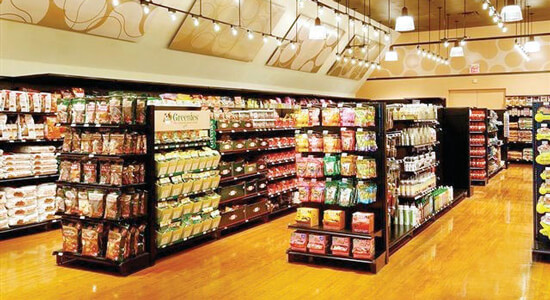In the ever competitive global market most people think racking and shelving is quite the same. However, this is not true. It is important to know the difference between these two. Let’s look at the major differences thus.
Shelving on the other hand is generally used for storage of things that need to be accessed by hand. These storage shelves are generally made of solid materials that can support small items. For example, shelves you would see at supermarkets.
Shelving

While racking is used for the storage of large quantities of stock in the warehouse. This method is made so that things can be accessed like boxes, or large containers. Machinery such as forklift is used in accessing stock due to the large capacity and weight of these boxes/storage crates.
Racking

We will now have a look at supermarket racking and shelving, the techniques and why it is important for any grocery or retail store.
The majority of these purchases are made in supermarkets, supermarkets or hypermarkets. On the other hand, it is proven that the good or the bad placement of a product in a shelving causes a difference of +/- 30% of turnover on this product.
These two facts show that the placement of products in supermarkets is a major issue in contemporary commerce, and therefore subject to optimization techniques. Such an optimization is conceived on several levels and several axes, presented in the first part of the study. Then we will restrict our study to placement in the "fresh products and yogurts" section.
The big rules
There are a number of requirements to be met when placing products in the store. These are guidelines that must always be kept in mind.
Location priorities need to be determined.
There will be one product per site or two if these products are complementary.
You have to create a mass effect. The more visible a product is, the more it sells.
It is necessary to facilitate the grip. Indeed, the art of investing is to sell the most products that one wants to sell, while making easy the shopping of the consumer.
Point-of-sale advertising must be simple. For a product, there is only one price visible and valid.
Store-wide optimization calculations, similar to those of the second part, are carried out first. The spokes with the best benefit / space ratio are placed in the center of the store. To attract customers, call products (food, consumables ...) are placed at the bottom of the store. The entrances are on the sides of the store, forcing the customer to go through the center.
This also makes it possible to respond to a logistic constraint: it is easier to place the call products at the bottom and on the sides, because the reserves are closer. It is the same for cans and drinks (water, juice, wine, alcohol). This avoids crossing the store with a heavy cart to renew the radius.
Department Heads must adapt to the customer's typical traffic plan. By walking perpendicularly to the rays, the customer sees the "positive" faces and turns his back on the "negative" faces of a double ray. The products that we want to put forward will be put on the positive part of the shelf. It is also necessary to force the client to stop and turn around by putting the necessities (natural yogurt, preserves) on the negative part.
Department managers must also adapt to the overall strategy of the moment. At Christmas, at school or during sales, they receive new constraints or opportunities to show their creativity and efficiency.